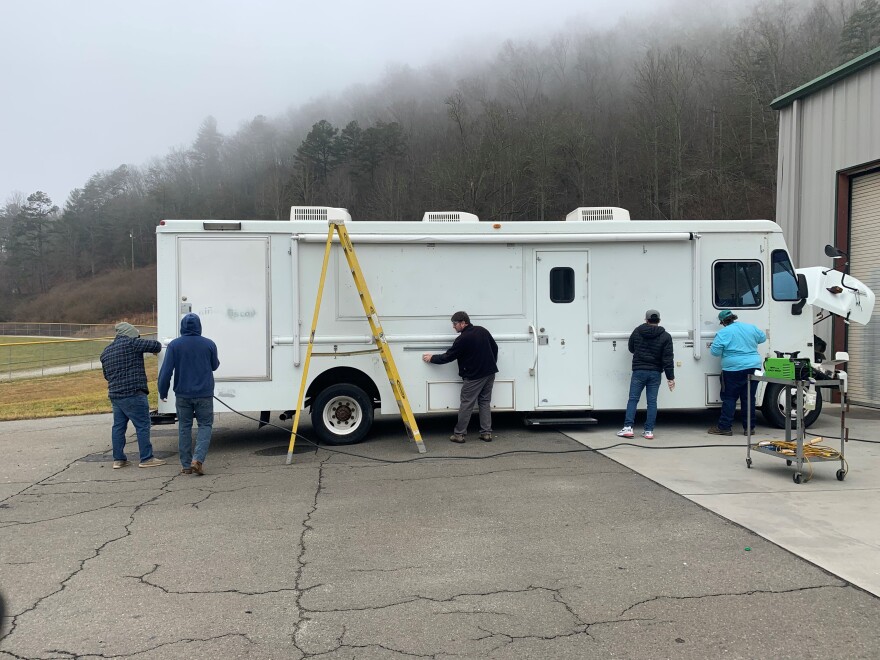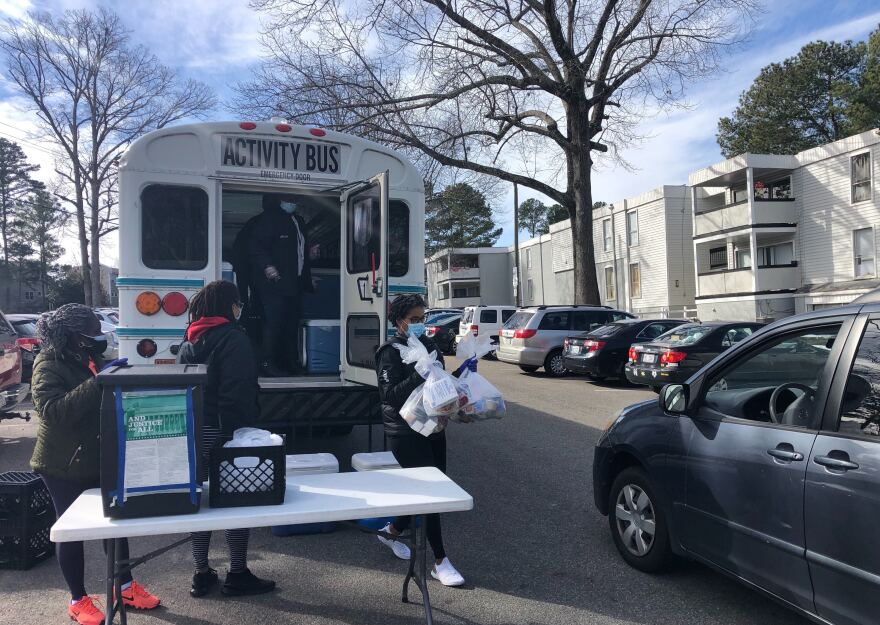On a winter Friday at Cedar Point Apartments in Raleigh, a school bus parks in the lot. But not to take students to class.
It’s here so kids and families can pick up meals without having to go all the way to their school.
Several women from Wake County Public Schools are here, with coolers and bags full of meals to give to children for the weekend. Two meals per day.
For Friday, cereal for breakfast, and cheeseburgers and french fries for lunch. Not to mention the bagged meals for Saturday and Sunday.

Every weekday Phyllis Bridges and Kerri Moore show up at the meal pickup site from 11 a.m. to 1 p.m. Several other women who work for the district are at the bus, too. They work in school nutrition or drive buses, during a normal school year.
Young kids, some looking particularly small and bundled up next to the huge bus, stop by to pick up meals for themselves and their siblings. Bridges or Moore help them carry the big bags of food, sometimes five or six, all the way to their apartment door.
People also come to the bus if it’s a closer drive than going to one of their children’s schools. Kim Carlile pulls up in a minivan — she has four kids, but none are in the car with her.
"They watched a clip of 'Finding Nemo' in class, and now she’s like… I don’t want to just watch part of it, I want to watch the whole thing," Carlile laughs.
The district also offers meal pickup appointments, and can drop-off directly at a student’s home.
Brenda Williams is tallying up all the meals on a clipboard. The USDA reimburses districts right now, for any child under 18 — student or not.
Remote learning has made it difficult for school districts to provide lunch to students who normally get it for free or at a reduced price in school cafeterias. That's led administrators to take creative steps to get food to kids who need it.
With more districts planning to get more kids in buildings in the coming weeks, the need for meals will continue, though it may take on a slightly different look. Each approach looks a little different to fit the community it’s in.
"Our challenge, statewide, has been trying to get those meals physically to children," said Lynn Harvey with the state Department of Public Instruction. "Largely because the school nutrition program is intended, by design and by regulation, to be a program where children are receiving those meals in a congregate setting."
Survey numbers from DPI shared with the legislature's education oversight committee show as few as 53% of students who qualify for free and reduced-price lunch received meals in December.

Tamara Baker with the Carolina Hunger Initiative says it’s part of a bigger problem that many are going hungry.
"We now say about one in four North Carolinians across the state on average are food insecure," Baker said. "But when it comes to certain school districts and certain counties — the need is even greater."
The toll of going without consistent meals for an extended period of time can be devastating.
"These are not just numbers, these are children and these are children who need that nutrition to feed their whole mind, body, and soul," Baker said. "And they cannot learn if they are not getting nutrition."
Logistical problems can get even worse as student in-person and remote schedules change constantly, and as districts bounce back and forth between in-person and remote learning.
In Graham County Schools on the state’s western border with Tennessee, that’s been a particular struggle.
"You’ve gotta send it out at the right temperatures, we had to borrow coolers from everybody in the county that we knew of [...] hot meals had to go out hot, cold meals had to stay cold," said Assistant District Superintendent Robert Moody. "We had 16 checkpoints in the county."

Now, the district has elementary students in person every day, but middle and high schoolers are only there a couple days a week. So the district doesn’t have enough staff to set up checkpoints for meal pickups.
So, they’ve invested in a new tool they hope will help reach those students stuck 30 minutes away — a food truck.
"It’s got commercial grade cookware, refrigerators, heaters, coolers, water," Moody said. "It’s got its own self-starting generator for power."
With all the effort and challenges to feed the kids that are accepting the meals, teachers and administrators all say their biggest worry is the kids they are not seeing, and trying to think of creative ways to stop them from going hungry.










